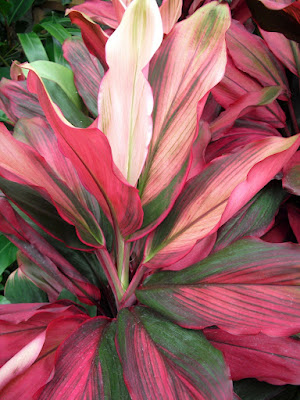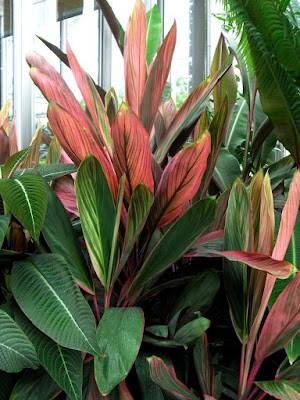The first Plant Lady I ever knew was my maternal grandmother, Lillian Brown. My mother and I lived with her for many years after my parents separated. She didn't own a lot of plants, say a dozen or so. But her fondness for houseplants is very much a part of what I remember, when I think of her.
 Hippeastrum 'Lilian' When I saw the name, I just had to buy this Amaryllis in honor of my grandmother. She did spell her name "Lillian," however.
Hippeastrum 'Lilian' When I saw the name, I just had to buy this Amaryllis in honor of my grandmother. She did spell her name "Lillian," however.
It's funny though, that except for the several pothos, (
Epipremnum aureum) I don't remember very clearly what those dozen plants were. Nana's house wasn't very sunny, so her plants were those that accepted less than ideal conditions with grace. Much like Nana did, throughout a rather complicated and difficult life.
A look at Google maps indicates that the suitable plant windows faced southwest and northeast, which, on the face of it, are decent exposures for growing. However, I recall that the windows were obstructed considerably by trees and nearby buildings. As for the rest of the plants, there was a small palm, I know, and a green
Syngonium, which she later gave to me when I was a teen and no longer living with her. There was something with a bit of a trunk, maybe a
Polyscias balfouriana. There were
Begonias, I'm sure, and a plant that I can't identify. I always thought I'd know it when I saw it, but I've seen hundreds of houseplants, both in person and pictures, and I've never come across it. All I recall is that stems were surrounded by the leaves, something like a
Crassula perforata, but it wasn't a succulent.
 Another view of Hippeastrum 'Lilian' showing the whole plant. The flowers are small and dainty, unlike many Hippeastrum cultivars. My grandmother wasn't a particularly small woman, but she had a delicateness in her demeanor that belied her inner strength.
Another view of Hippeastrum 'Lilian' showing the whole plant. The flowers are small and dainty, unlike many Hippeastrum cultivars. My grandmother wasn't a particularly small woman, but she had a delicateness in her demeanor that belied her inner strength.
Nana worked very hard, both as a cleaning lady for several clients, and in taking care of our home. She also spent a lot of time taking care of me, while my mother worked and pursued a social life. So she didn't have a lot of time to devote to plant care. But her plants were always well watered, well groomed, well loved. Every summer, the plants would line the edges of our tiny front porch, soaking up the sunshine. When I was little, my mother and I would sometimes try to add to the plant collection, usually with disastrous results. Either we'd buy something totally unsuitable for the conditions, or something no one knew how to take care of. One such gift was a magnificent
Caladium bicolor 'Candidum.' None of us knew that it was
supposed to die back at the end of the season, and that it could be regrown from its tubers in the spring. So we all watched with dismay as the huge leaves withered and died over several weeks.
 I was holding a camera at an odd angle when I took this picture. On one hand, it is vertigo-inducing. On the other had, it shows the actual color of the flowers well, so I decided to include it.
I was holding a camera at an odd angle when I took this picture. On one hand, it is vertigo-inducing. On the other had, it shows the actual color of the flowers well, so I decided to include it.
A happier memory I have is of planting apple and orange seeds together, in old margarine containers, just to see what would happen. I would have been about seven, I guess. Nana chose oranges and I chose apples. I was thrilled when the orange seeds sprouted, and a bit disappointed when the apples never did. But is was something we enjoyed together. We were a lot alike in many ways.
Nana died in 1978, about a month before my eighteenth birthday. People sometimes said that I looked just like her, and I always wondered why, since our facial features were not particularly similar. But then, years later, I saw myself on video, about a half hour's worth. I noticed that I have most of her general mannerisms, from my posture to the way I walk to the gestures I make with my hands. Even with dissimilar features, my facial expressions also echo hers to a surprising degree. And of course, we are both Plant Ladies.
 Hedera helix 'Minty,' also known as Hedera helix 'Mint Kolibri.' This is one of the plants that I lost, and one of the few I will replace if/when I come across another one.
Hedera helix 'Minty,' also known as Hedera helix 'Mint Kolibri.' This is one of the plants that I lost, and one of the few I will replace if/when I come across another one.





































